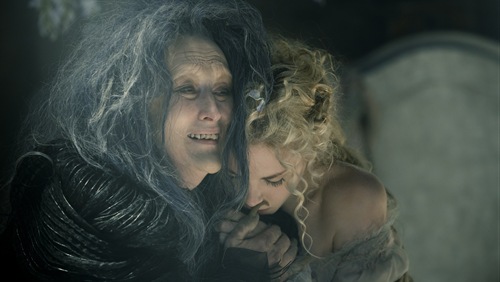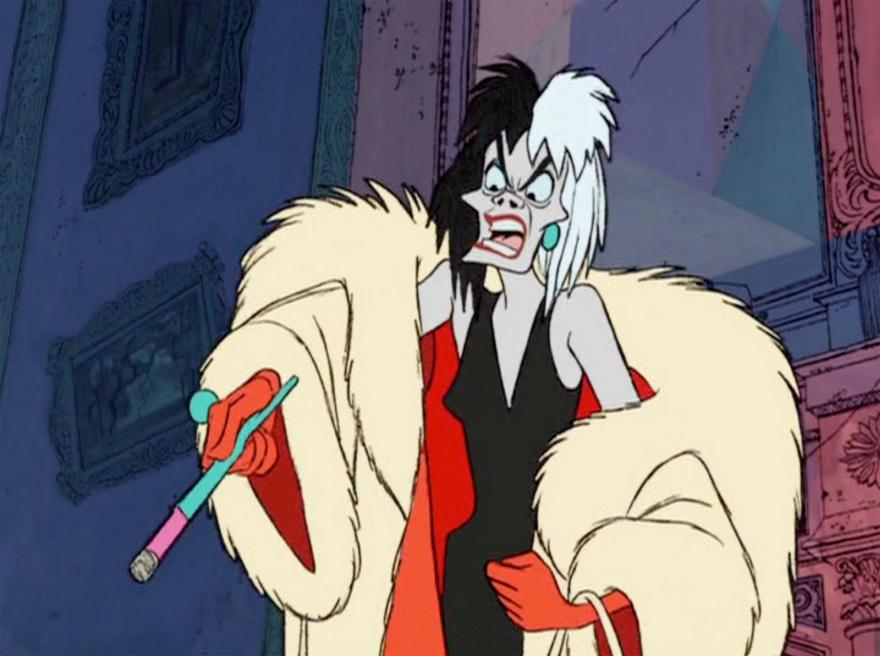Written by Katherine Murray.
Your dad is an ogre or giant, your mom is a witch, and both of them want to kill you. Welcome to your fairy tale life.

If you’ve ever read a fairy tale before, the idea that mother figures end up being witches is not exactly news. Young, beautiful, kind, and loving parents (mothers, especially) are usually MIA or KIA before the action starts, and the child heroes instead interact with angry, powerful fantasy characters who are about the same age their parents would be, and fill some of the same roles their parents would fill, but also want to murder them in shocking and terrible ways.
The clearest example of this is probably Hansel and Gretel, where parents eat their own children through the proxy of a witch, but it’s a theme that repeats itself in children’s literature.
Disney’s adaptation of Into the Woods contains a smorgasbord of missing parents, one of whom is replaced by a bone-crushing giant, and one of whom is replaced by a witch. The giant comes into play during the movie’s riff on Jack and the Beanstalk, where fatherless Jack meets an oedipal complex a “big tall terrible lady giant” who behaves toward him as a mother would before her husband tries to eat Jack for lunch (as recapped in this song). The witch is a more developed character, and a better example of what Into the Woods has to offer as an adult-oriented fairy tale.
The witch, who isn’t ever named, plays a role in multiple plot lines, but her origin is in Rapunzel. After catching her neighbour trying to make off with her vegetables, she curses him and locks his daughter in a tower, raising the girl as her own. From there, the story progresses in the usual way – Rapunzel meets a prince; the witch becomes jealous and attacks them; Rapunzel is reunited with her prince and leaves the witch behind forever.
Some of the commentary on Into the Woods (both the movie and the pre-Disney musical) has painted the relationship between Rapunzel and the witch as one about parents struggling to let go of their children and wanting to shelter them from the dangers of the world. James Lapine and Stephen Sondheim even introduce the witch’s signature song, “Stay with Me” as a touching song about family relationships that’s supposed to show us a gentler side of the witch.
And, while it’s true that “Stay with Me” presents the witch as an emotionally complex person, it also presents her as a pretty shitty parent. If you listen to the whole thing, including how the scene begins and ends, she’s emotionally manipulative, self-centred, prone to sudden fits of anger, and unreasonably punitive.
Kind of like Rapunzel’s witch mom in that other Disney movie.

In fact, I wouldn’t be surprised if the dynamic in Into the Woods influenced Tangled in some way.
Tangled is a lot less nuanced in its presentation – the witch in Tangled is purely self-interested and doesn’t show any signs of genuine affection for Rapunzel. In this version of the story, Rapunzel unknowingly has the power to rejuvenate people, and the witch wants her to stay in the tower and act as a personal fountain of youth. As part of her plan to keep Rapunzel under control, she systematically destroys Rapunzel’s confidence and self-esteem, convincing her that she’s so ugly, helpless, and stupid that she’d never survive on her own, and no one else would want her.
The turning point in the story comes when Rapunzel, who’s been raised by an abusive parent her entire life, without anything else to compare it to, realizes that her witch mother doesn’t really love her, and that she deserves to be part of a family that treats her with kindness and respect.
Into the Woods, which is intended for an audience of adults, is more layered. It’s clear that the witch feels more than one way about Rapunzel. It’s not a case where she’s just lying when she says she loves her daughter, but she displays a selfish, greedy kind of love that turns Rapunzel into an object whose feelings and needs aren’t important.
In the movie, their story arc ends when Rapunzel rides into the woods with her prince, vowing never to see the witch again. The second act of the musical, on stage, is much more explicit in showing us the long-term fallout of Rapunzel’s awful childhood – even though things are all right for her now, she can’t ever be happy because of the way she was raised. It’s an experience that’s going to haunt her forever.
Treating your children as things you own that exist to make you happy – and treating them as things that are defective, when they don’t make you happy – is an abusive form of parenting that more than one witch mother seems to exhibit.

Other Mother, the villain of Coraline, doesn’t have a pointy hat and a broom, but she’s a supernatural creature with magic powers who stands in for Coraline’s real mother in much of the movie.
In this case, the swap is more literal. Coraline, feeling temporarily neglected by her parents, finds a door behind the wallpaper in her house, leading to a world where everything is way more fun an interesting. The Other world is a copy of the world Coraline lives in, where everything revolves around her, and where she is (initially) welcomed by an alternate version of her mother, who’s far more attentive, warm and happy. The only thing Coraline has to do to stay in the world where everything’s awesome and great all the time is let Other Mother carve out her eyes.
When Coraline asserts herself by politely refusing to do that, Other Mother turns into a monster who rages at Coraline for disappointing her, kidnaps Coraline’s real parents, and tries to trap Coraline in the Other world forever. We then learn that Other Mother controls everyone else in the Other world, punishing them if they don’t seem happy enough, and forbidding them to talk to each other when she’s not there.
When Coraline asks why Other Mother is so determined to keep her in the Other world, one of the other characters explains that she wants something to love that isn’t her – or, possibly, “She’d just love something to eat.”
The story resolves when Coraline escapes from Other Mother, and realizes that her parents, although they’re not perfect, genuinely love her, care about her feelings and well-being, and, unlike Other Mother, would never hurt her on purpose. The smothering, overly-attentive “love” that Other Mother initially displays for Coraline is really a greedy, hungry desire for something to trap and control. Love doesn’t mean giving someone everything you have so as to buy the right to keep them.

In most children’s stories, the substitution of witch for mom or giant for dad is a safe way of exploring children’s fears about their parents. Children need their parents to take care of them, which leaves them at their parents’ mercy; even good parents sometimes express sides of themselves that their children find frightening or confusing – stories where children are mistreated or endangered by mother and father figures who aren’t literally their parents provide a way to confront the fear of mistreatment or endangerment while also providing a safety net that says, “Your real mom and dad aren’t like this.” In other words, it’s too awful to think that your mother is evil, so she becomes two people – one that’s nice (and dead or gone) and one that’s really mean.
Because Other Mother looks and sounds just like Coraline’s real mother, the association between nice mom and mean mom is more obvious in Coraline, but the distance between Coraline’s actual mother and the monster behind the wallpaper is clear. One is a reasonable human being and one is an imposter.
Spirited Away, a Japanese film directed by Hayao Miyazaki, offers a more nuanced reading of the switch between nice mom and mean mom, with the witch grandmother Yubaba. Yubaba is murderous and terrifying, but is occasionally replaced by her kindly “twin sister” who invites the movie’s heroine to call her “grandma” and likes to make people tea and knit sweaters. In general terms, Miyazaki’s films seem comfortable with the idea that people aren’t all one way – that there are many, sometimes contradictory sides to our personalities, that are expressed at different times. By the end of Spirited Away, it’s strongly implied that Yubaba and her “sister” are actually the same person, each expressing different aspects of who she is.
The typical witch substitution removes all the negative aspects from mom, and sends them out into the world as a monster that can be defeated. It’s rare to find a mother figure who’s capable of both kindness and cruelty, and rarer still to find one who is predominantly cruel, without being wicked all the way through.
Where Other Mother and the witch from Tangled are pure evil wearing the mask of friendship, the witch from Into the Woods is the rare example of a mother figure who’s mostly bad, with occasional moments of goodness. That fits the story’s more mature approach to fairy tales, and its overarching message that right and wrong and good and bad are not as clear as children’s books would make them seem.
If the child-eaters of children’s stories are monsters, the ones in real life are more likely to be like the witch in Into the Woods: emotionally-immature adults with poor boundaries, who see their children as things that belong to them, like lamps and cars. They can be nice sometimes. They can elicit pity. They can express vulnerable emotions, and they can share common experiences with parents who are mostly good. They honestly do want something to love, but they’d also love something to eat.
We’re so used to seeing negative human qualities externalized into monsters, that’s it’s still surprising when a character is both monstrous and recognizably human. In a story that’s about adulthood, and coming to understand yourself and the world more clearly, the crucial move Into the Woods makes is in allowing Rapunzel’s witch mother to be her “real” mother – the only one she’ll ever know. The childhood projections of nice mom and mean mom collapse into one single person, and the thought that was too terrible to entertain in childhood – that maybe your mom is a witch – becomes real, layered and deepened through the knowledge that witches can also be people.
Katherine Murray is a Toronto-based writer who yells about movies and TV on her blog.

















